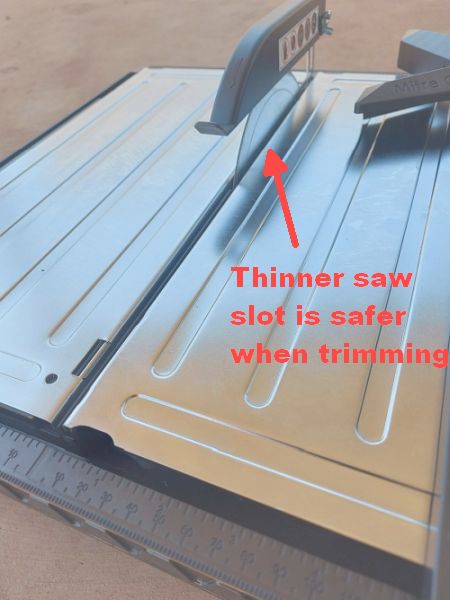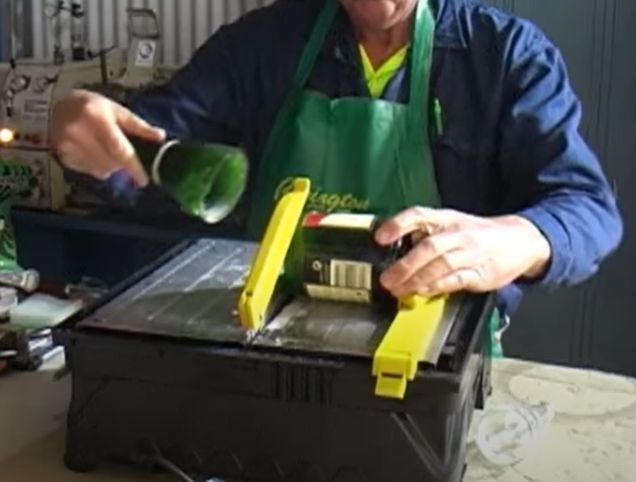People often ask if they can use a Tile Cutter for lapidary work and the simple answer is YES !
The slightly more complicated answer is YES but there are some things to watch out for.
The big advantage of Tile Saws is that they are generally a lot cheaper than Lapidary Trim Saws so if you are on a budget, then this is definitely an option worth exploring. The 180mm or 7 inch size is very popular as it is a good compromise of price point and cutting depth. So the following discussion will focus on that size of saw.
Tile Saws will be supplied with a Tile Blade - these are a continuous rim (sintered) diamond blade but they are very thick and coarse so not really suitable for cutting lapidary material or glass. So you need to be able to fit a thinner and more suitable blade to the saw to cut your rough.
 This is where we come across the first potential pitfall - most 180 mm saws that are readily available at hardware shops have a 22.2mm shaft (7/8") so your choice of blade is more restricted. You generally need to buy a 1 inch bore blade and get it bushed down to 7/8". The 7" Tile Saw supplied by Aussie Sapphire has a 5/8" shaft which is a more common size for lapidary style blades. Before purchasing a saw that looks cheap, make sure you can source suitable blades for it and factor in that cost.
This is where we come across the first potential pitfall - most 180 mm saws that are readily available at hardware shops have a 22.2mm shaft (7/8") so your choice of blade is more restricted. You generally need to buy a 1 inch bore blade and get it bushed down to 7/8". The 7" Tile Saw supplied by Aussie Sapphire has a 5/8" shaft which is a more common size for lapidary style blades. Before purchasing a saw that looks cheap, make sure you can source suitable blades for it and factor in that cost.
Tile blades will be around 0.070" (1.8 mm) or so thick and quite coarse. Lapidary blades will be around 0.032" thick or 0.8 mm for general purpose cutting or thinner for very valuable material where you want to minimise wastage. Price will vary according to type ranging from very cheap notched rim blades up to very expensive for 1" bore sintered blades. All will cut stone but lifespan will vary depending on blade type - see this article for more information about blade types and how to choose. Our current range of 7 inch blades is listed here.
The second issue is that some tile saws have quite a large slot in the saw table meaning there is quite a large gap between the blade and the edge of the saw table. This can make it easier for a rock to jam during sawing which can be dangerous. We always recommend wearing eye protection whenever using a saw but saws with a thin slot will be safer to use.
Cutting Depth
180mm or 7 inch tile saws will generally have a cutting depth of almost 30mm. There is very little variation between brands on this due to the design of these saws. This is usually sufficient for cutting slabs into pieces suitable for cabbing, faceting rough, trimming smaller tumbling rough, cutting glass for mosaic or leadlighting work, etc. If you need more than that, you may need to consider a larger saw. We have found these saws to be very popular for people wanting to cut glass bottles for various projects - the cutting depth is insufficient to do this in one pass but it can be achieved by rotating the bottle as you cut as shown in this video.

This leads into some comments for glassworkers. We have found these saws fitted with the electroplated blades to be very popular with glassworkers. They are very suitable for those doing mosaic work, leadlighting, glass art, ceramic upcycling, etc. One advantage is the flat saw table - unlike lapidary trim saws which usually have a raised edge around the saw table, these are flat so you can still work with a piece of glass that is larger than the saw table. Straight edges and angle guides can be useful for some types of work and are usually included with most saws.
SAFETY:
These are quite safe to use but you do need to follow some simple safety guidelines. Stone or glass dust can be dangerous to your lungs so ALWAYS cut wet and ideally wear a dust mask. Diamond blades will be destroyed very quickly if used dry so always make sure there is sufficient water (coolant) in the reservoir to protect your health and prolong blade life. Eye protection is also recommended when using a saw. Diamond blades are not very dangerous - unlike toothed wood blades which can rip fingers, diamond blades work by grinding so you are unlikely to cut yourself if you inadvertently touch the blade while the saw is operating. However, use of finger safety tape or surgical gloves can assist to hold the stone securely and safely when cutting. Avoid using excessive pressure when cutting - this does not cut faster but just wears blades out prematurely.
So the bottom line is that a tile saw is worth considering if you need a trim saw at an affordable cost. Look for a supplier that can provide technical support and supply consumables into the future. Or simply follow this link to purchase a proven performer from Aussie Sapphire





.jpg)


